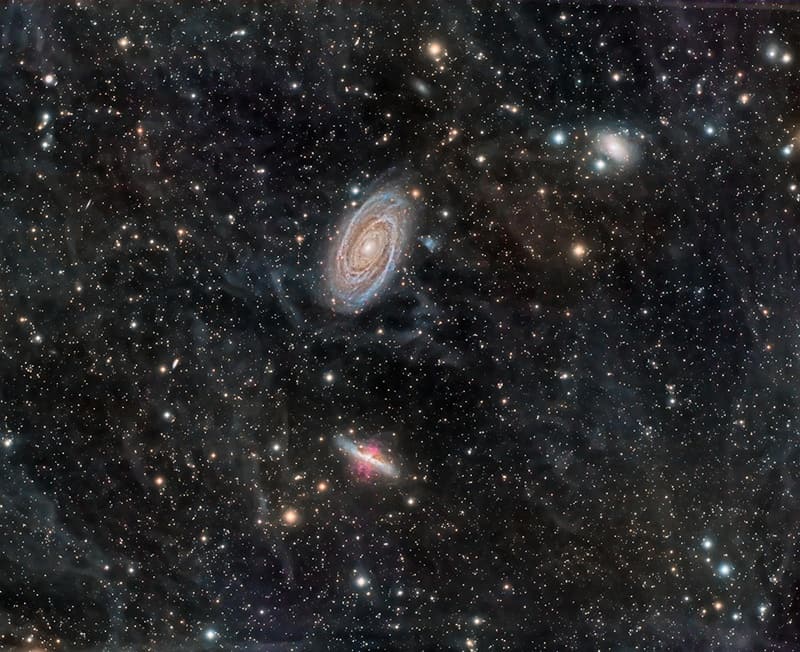Blog
https://www.youtube.com/watch?v=f0TmSXKwCvc
more...The Wide Field Imager on the MPG/ESO 2.2-metre telescope at the La Silla Observatory has imaged a region of star formation called NGC 3324. The intense radiation from several of NGC 3324’s massive, blue-white stars has carved out a cavity in the surrounding gas and dust. The ultraviolet radiation from these young hot stars also cause the gas cloud to glow in rich colours.
NGC 3324 is an open cluster in the southern constellation Carina, located northwest of the Carina Nebula (NGC 3372) at a distance of 7,560 ly(2,317 pc) from Earth. It is closely associated with the emission nebula IC 2599, also known as Gum 31. The two are often confused as a single object, and together have been nicknamed the “Gabriela Mistral Nebula” due to its resemblance to the Chilean poet. NGC 3324 was first catalogued by James Dunlop in 1826.

The Wide Field Imager on the MPG/ESO 2.2-metre telescope at the La Silla Observatory has imaged a region of star formation called NGC 3324. The intense radiation from several of NGC 3324’s massive, blue-white stars has carved out a cavity in the surrounding gas and dust. The ultraviolet radiation from these young hot stars also cause the gas cloud to glow in rich colours.
Stephen William Bragg (born 20 December 1957) is an English singer-songwriter and left-wing activist. His music blends elements of folk music, punk rock and protest songs, with lyrics that mostly span political or romantic themes. His music is heavily centred on bringing about change and involving the younger generation in activist causes.
Bragg was born in 1957 in Barking, Essex, one of the sons of Dennis Frederick Austin Bragg, an assistant sales manager to a Barking cap maker and milliner, and his wife Marie Victoria D’Urso, who was of Italian descent. Bragg’s father died of lung cancer in 1976, and his mother in 2011.
more...Lawrence Elliott Willis (December 20, 1942 – September 29, 2019) was an American jazz pianist and composer. He performed in a wide range of styles, including jazz fusion, Afro-Cuban jazz, bebop, and avant-garde.
Willis was born in New York City. After his first year studying music theory at the Manhattan School of Music he began performing regularly with Jackie McLean. After he graduated he made his first jazz recording, McLean’s Right Now! in January 1965, which featured two of Willis’ compositions. His first recording of any type, however, was as a singer with the Music and Arts Chorale Ensemble, performing an opera by Aaron Copland under the direction of Leonard Bernstein. He decided to concentrate on jazz because of the difficulties African-American musicians had in finding work in concert music.
Throughout his career he performed with a wide range of musicians, including several years as keyboardist for Blood, Sweat & Tears (beginning in 1972). He spent several years as pianist for trumpeters Nat Adderley and Woody Shaw as well as long and productive tenures with Roy Hargrove and with Jerry Gonzalez and his Fort Apache Band. His late recording with Paul Murphy, Exposé, demonstrated the fusion principles of bebop and avant-garde jazz. His composition “Sanctuary” began exploring works employing strings. After a successful performance in Frank Lloyd Wright‘s Annie Pfieffer Chapel at Florida Southern College‘s Child of the Sun Jazz Festival he was commissioned to write a full-scale orchestral work for jazz trio and orchestra. He worked with Hugh Masekela on a South African Suite of music and interpreted Miles Davis‘ work. He was in the Round About Midnight tour of Miles Davis’ music. He received the Don Redman award in 2011, and the Benny Golson Jazz Master Award at Howard University in 2012.
more...Pleasant Joseph known as Cousin Joe (December 20, 1907 — October 2, 1989) was an American blues and jazz singer, later famous for his 1940s recordings with clarinetist Sidney Bechet and saxophonist Mezz Mezzrow.
He was born in Wallace, Louisiana, United States and worked at Whitney Plantation throughout his childhood.
Until 1945 Cousin Joe toured Louisiana; that year he was asked to take part in the King Jazz recording sessions organized by Mezzrow and Bechet. Cousin Joe died in his sleep from natural causes in New Orleans, at the age of 81.
more...Soléa por Bulerías combines standard chord patterns associated with the Soleares with the pulse of the Bulerías.
A Bb Bb/D Bb/C Bb A
12123 4567 8 9 1011
The Llamada
A Bb Bb C Bb A
12123 4567 8 9 1011
The letra
A Bb Bb A
12123 4567 8 9 1011
more...ESO’s Very Large Telescope in Chile has captured the most detailed image ever taken of the Medusa Nebula (also known Abell 21 and Sharpless 2-274). As the star at the heart of this nebula made its final transition into retirement, it shed its outer layers into space, forming this colourful cloud. The image foreshadows the final fate of the Sun, which will eventually also become an object of this kind.
The Medusa Nebula is a large planetary nebula in the constellation of Gemini on the Canis Minor border. It is also known as Abell 21 and Sharpless2-274. It was originally discovered in 1955 by UCLA astronomer George O. Abell, who classified it as an old planetary nebula. The braided serpentine filaments of glowing gas suggests the serpent hair of Medusa found in ancient Greek mythology.
Until the early 1970s, the Medusa was thought to be a supernova remnant. With the computation of expansion velocities and the thermal character of the radio emission, Soviet astronomers in 1971 concluded that it was most likely a planetary nebula.
As the nebula is so big, its surface brightness is very low, with surface magnitudes of between +15.99 and +25 reported. Because of this most websites recommend at least an 8-inch (200 mm) telescope with an [O III] filter to find this object although probably possible to image with smaller apertures.

ESO’s Very Large Telescope in Chile has captured the most detailed image ever taken of the Medusa Nebula (also known Abell 21 and Sharpless 2-274). As the star at the heart of this nebula made its final transition into retirement, it shed its outer layers into space, forming this colourful cloud. The image foreshadows the final fate of the Sun, which will eventually also become an object of this kind.
Kermit Ruffins (born December 19, 1964) is an American jazz trumpeter, singer, and composer from New Orleans, Louisiana, United States. He has been influenced by Louis Armstrong and Louis Jordan and says that the highest note he can hit on trumpet is a high C. He often accompanies his songs with his own vocals. Most of his bands perform New Orleans jazz standards, though he also composes many of his own pieces. Jon Pareles of The New York Times wrote, “Mr. Ruffins is an unabashed entertainer who plays trumpet with a bright, silvery tone, sings with off-the-cuff charm and never gets too abstruse in his material.”
He started playing trumpet in 8th grade at Lawless Junior High School in the Ninth Ward of New Orleans. He attended Joseph S. Clark High School in the 6th Ward. In high school, he played a little bit of classical music at the behest of a strict band teacher. He developed an appreciation for cooking from his grandmother, observing her movements in the kitchen.
more...Leonard White III (born December 19, 1949) is a three-time Grammy Award-winning American jazz fusion drummer, born in New York City, best known for being the drummer of Chick Corea‘s Return to Forever. A resident of Teaneck, New Jersey, White has been described as “one of the founding fathers of jazz fusion”.
Born in Queens, New York City, White became interested in music at a young age. As a self taught drummer he started off his career playing with groups at the New York jazz scene. During the late 1960s he began performing with saxophonist Jackie Mclean. He went on to play on Miles Davis‘ landmark 1969 LP Bitches’ Brew and feature on Freddie Hubbard‘s 1970 LP Red Clay. Within 1972 White joined the famed jazz group Return to Forever.
more...Robert Henry Timmons (December 19, 1935 – March 1, 1974) was an American jazz pianist and composer. He was a sideman in Art Blakey‘s Jazz Messengers for two periods (July 1958 to September 1959; February 1960 to June 1961), between which he was part of Cannonball Adderley‘s band. Several of Timmons’ compositions written when part of these bands – including “Moanin’“, “Dat Dere“, and “This Here” – enjoyed commercial success and brought him more attention. In the early and mid-1960s he led a series of piano trios that toured and recorded extensively.
Timmons was strongly associated with the soul jazz style that he helped initiate. This link to apparently simple writing and playing, coupled with drug and alcohol addiction, led to a decline in his career. Timmons died, aged 38, from cirrhosis. Several critics have commented that his contribution to jazz remains undervalued.
Timmons was born in Philadelphia, Pennsylvania, the son of a minister. He had a sister, Eleanor. Both of his parents, and several aunts and uncles, played the piano. From an early age Timmons studied music with an uncle, Robert Habershaw, who also taught McCoy Tyner. Timmons first played at the church where his grandfather was minister; this influenced his later jazz playing. He grew up in the same area as other future musicians, including the Heath brothers, Jimmy, Percy, and Tootie. Timmons’ first professional performances were in his local area, often as a trio that included Tootie Heath on drums. After graduating from high school Timmons was awarded a scholarship to study at the Philadelphia Musical Academy.
Timmons moved to New York in 1954. He played with Kenny Dorham in 1956, making his recording debut with the trumpeter in a live set in May of that year. He went on to play and record with Chet Baker in 1956–57 (bassist Scott LaFaro was part of this band for a time), Sonny Stitt in 1957, and Maynard Ferguson in 1957–58. He also recorded as a sideman with hornmen Curtis Fuller, Hank Mobley, and Lee Morgan, all for Blue Note Records in 1957.
more...Henry Roeland “Roy” Byrd (December 19, 1918 – January 30, 1980), better known as Professor Longhair or “Fess” for short, was an American singer and pianist who performed New Orleans blues. He was active in two distinct periods, first in the heyday of early rhythm and blues and later in the resurgence of interest in traditional jazz after the founding of the New Orleans Jazz and Heritage Festival in 1970. His piano style has been described as “instantly recognizable, combining rumba, mambo, and calypso.”
Music journalist Tony Russell (in his book The Blues: From Robert Johnson to Robert Cray) wrote that “The vivacious rhumba-rhythmed piano blues and choked singing typical of Fess were too weird to sell millions of records; he had to be content with siring musical offspring who were simple enough to manage that, like Fats Domino or Huey “Piano” Smith. But he is also acknowledged as a father figure by subtler players like Allen Toussaintand Dr. John.”
Byrd was born on December 19, 1918, in Bogalusa, Louisiana. His distinctive style of piano playing was influenced by learning to play on an instrument that was missing some keys. He left the city as a baby with his parents, who were most likely fleeing the racial tension surrounding the Bogalusa Massacre.
He began his career in New Orleans in 1948. Mike Tessitore, owner of the Caldonia Club, gave Longhair his stage name. Longhair first recorded in a band called the Shuffling Hungarians in 1949, creating four songs (including the first version of his signature song, “Mardi Gras in New Orleans”) for the Star Talent record label. Union problems curtailed their release, but Longhair’s next effort for Mercury Records the same year was a winner. Throughout the 1950s, he recorded for Atlantic Records, Federal Records and local labels. Professor Longhair had only one national commercial hit, “Bald Head”, in 1950, under the name Roy Byrd and His Blues Jumpers. He also recorded his favorites, “Tipitina” and “Go to the Mardi Gras“. He lacked crossover appeal among white and wide audiences. Yet, he is regarded (and was acknowledged) as being a musician who was highly influential for other prominent musicians, such as Fats Domino, Allen Toussaint and Dr. John.
more...Édith Piaf (UK: /ˈpiːæf/, US: /piːˈɑːf/; French: [edit pjaf] (![]() listen); born Édith Giovanna Gassion, French: [edit dʒɔvana ɡasjɔ̃]; 19 December 1915 – 10 October 1963) was a French singer-songwriter, cabaret performer and film actress noted as France’s national chanteuse and one of the country’s most widely known international stars.
listen); born Édith Giovanna Gassion, French: [edit dʒɔvana ɡasjɔ̃]; 19 December 1915 – 10 October 1963) was a French singer-songwriter, cabaret performer and film actress noted as France’s national chanteuse and one of the country’s most widely known international stars.
Piaf’s music was often autobiographical and she specialized in chanson and torch ballads about love, loss and sorrow. Her most widely known songs include “La Vie en rose” (1946), “Non, je ne regrette rien” (1960), “Hymne à l’amour” (1949), “Milord” (1959), “La Foule” (1957), “L’Accordéoniste” (1940) and “Padam, padam…” (1951).
Since her death in 1963, several biographies and films have studied her life, including 2007’s Academy Award-winning La Vie en rose — Piaf has become one of the most celebrated performers of the 20th century.
more...Bode’s Galaxy (M81) and the Cigar Galaxy (M82) lie in the constellation Ursa Major the Great Bear. In addition to these standout objects, however, notice the vast amount of nebulosity in the region. That’s called the Integrated Flux Nebula.
Messier 81 (also known as NGC 3031 or Bode’s Galaxy) is a spiral galaxy about 12 million light-years away, with a diameter of 90,000 light years, about half the size of the Milky Way, in the constellation Ursa Major. Due to its proximity to Earth, large size, and active galactic nucleus (which harbors a 70 million M☉ supermassive black hole), Messier 81 has been studied extensively by professional astronomers. The galaxy’s large size and relatively high brightness also makes it a popular target for amateur astronomers.

more...
Keith Richards (born 18 December 1943) is an English musician, singer, and songwriter. He is best known as the co-founder, guitarist, secondary vocalist, and co-principal songwriter of the Rolling Stones. Rolling Stone magazine called Richards the creator of “rock’s greatest single body of riffs” on guitar and ranked him fourth on its list of 100 best guitarists in 2011. The magazine lists fourteen songs that Richards wrote with the Rolling Stones’ lead vocalist Mick Jagger on its “Rolling Stone’s 500 Greatest Songs of All Time” list.
Richards plays both lead and rhythm guitar parts, often in the same song, as the Stones are generally known for their guitar interplay of rhythm and lead (“weaving”) between Richards and the other guitarist in the band – Brian Jones (1962–1969), Mick Taylor (1969–1975), and Ronnie Wood (1975–present). In the recording studio, Richards sometimes plays all of the guitar parts, notably on the songs “Paint It Black“, “Ruby Tuesday“, “Sympathy for the Devil“, and “Gimme Shelter“. He is also a vocalist, singing backing vocals on many Rolling Stones songs as well as occasional lead vocals, such as on the Rolling Stones’ 1972 single “Happy“, as well as with his side project, the X-Pensive Winos.
more...Ishmael Wadada Leo Smith (born December 18, 1941) is an American trumpeter and composer, working primarily in the fields of avant-garde jazz and free improvisation. He was one of three finalists for the 2013 Pulitzer Prize for Music for Ten Freedom Summers, released on May 22, 2012.
Smith was born in Leland, Mississippi. He started out playing drums, mellophone, and French horn before he settled on the trumpet. He played in various R&B groups and by 1967 became a member of the AACM and co-founded the Creative Construction Company, a trio with Leroy Jenkins and Anthony Braxton. In 1971, Smith formed his own label, Kabell. He also formed another band, the New Dalta Ahkri, with members including Henry Threadgill, Anthony Davis and Oliver Lake.
In the 1970s, Smith studied ethnomusicology at Wesleyan University. He played again with Anthony Braxton, as well as recording with Derek Bailey‘s Company. In the mid-1980s, Smith became Rastafarian and began using the name Wadada. In 1993, he began teaching at Cal Arts, a position he held until 2014. In addition to trumpet and flugelhorn, Smith plays several world music instruments, including the koto, kalimba, and atenteben (Ghanaian bamboo flute). He has also taught courses in instrument making. His compositions often use a graphic notation system he calls “Ankhrasmation”, which he developed in 1970.
https://www.youtube.com/watch?v=e55q1Mhp-EI
more...More Posts
- The Cosmos with NGC 4302 and NGC 4298
- Steve Gadd Day
- Reuben Wilson Day
- Mance Lipscomb Day
- World Fusion with Chen Jie-bing
- Daily Roots with The Bullwackie’s All Stars
- The Cosmos with NGC 6960
- Steve Howe Day
- Tommy McClennan Day
- Carmen McRae Day
- World Music with Matato’a
- Daily Roots with Michael Prophet
- The Cosmos with Supernova Remnant 1E 0102.2-7219
- Freddie Hubbard Day
- Mongo Santamaria Day
- Billie Holiday Day
- World Fusion with Istvan Sky Kék Ég, Estas Tonne, Pablo Arellano, Indrė Kuliešiūtė.
- Daily Roots with the Mighty Diamonds
- The Cosmos with NGC 3324
- John Pizzarelli Day